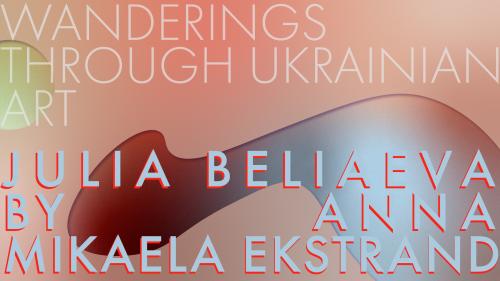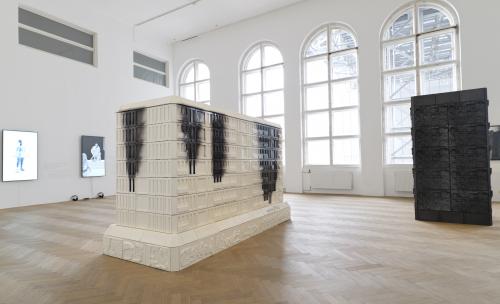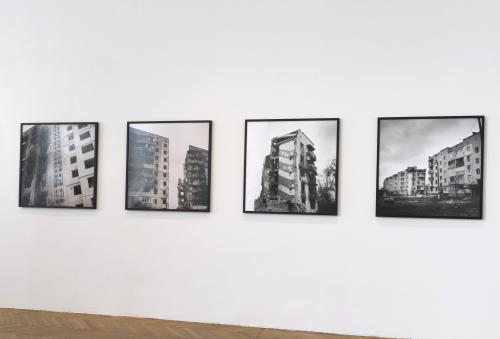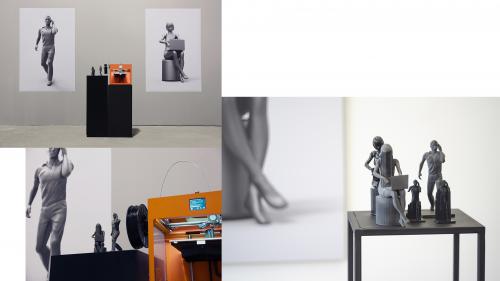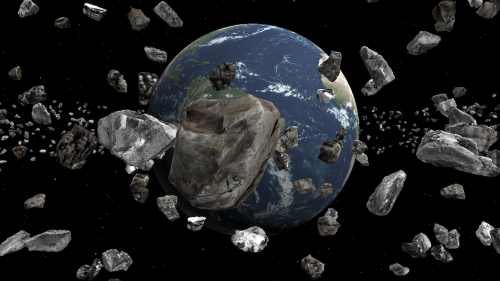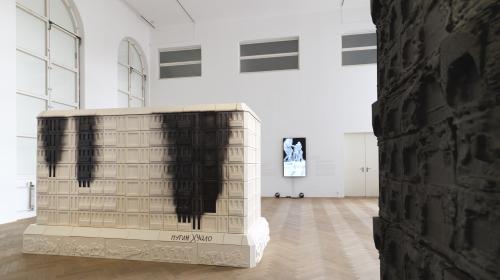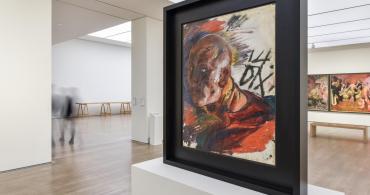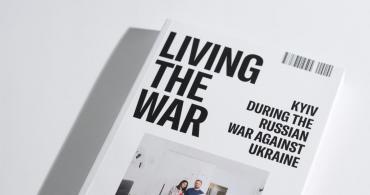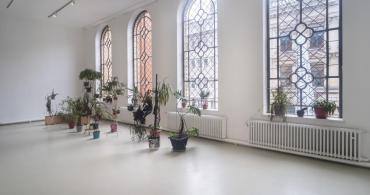Influenced by War, Julia Beliaeva Investigates Ukrainian History through Her Tech-Heavy Practice
10 may, 2023
Within the framework of the project Wanderings Through Ukrainian Art, Anna Mikaela Ekstrand, New York-based critic and curator, analyzes the work of Julia Beliaeva. We share this text with the documentation of Julia Beliaeva's solo exhibition Fragile City at OK Culture Linz, comprisig artist's leading projects of recent years. The exhibition is on view until May 21, 2023.
Ukrainian artist Julia Beliaeva’s multi-disciplinary practice — 3D printed sculpture, VR, and robot-driven drawing, among others — investigate the human condition and tensions we face in the quotidien; what emotions processes of modernization and suppression of history produce and the memories that remain. Series like “Working Class” and “The Last Childhood in the City” nod to the Soviet Union’s propaganda machine that glorified workers and suppressed human rights abuses leaving traces of fear and neuroses in the Ukrainian population. Her most recent work “Fragile City” explores modernization after independence charting the shift away from tiled stoves to heat homes while contemplating the scars left by the Russian attack on Ukraine. Beliaeva started this series in Kyiv but finished it in Linz, Austria where she resided during the early days of the full-scale invasion. In part, Belieava rewrites Ukrainian history to add more counternarratives to dominant Russian imperalist history and it is this determination that continues to lead her forward in her work.
Ukrainian artist Julia Beliaeva’s multi-disciplinary practice — 3D printed sculpture, VR, and robot-driven drawing, among others — investigate the human condition and tensions we face in the quotidien; what emotions processes of modernization and suppression of history produce and the memories that remain. Series like “Working Class” and “The Last Childhood in the City” nod to the Soviet Union’s propaganda machine that glorified workers and suppressed human rights abuses leaving traces of fear and neuroses in the Ukrainian population. Her most recent work “Fragile City” explores modernization after independence charting the shift away from tiled stoves to heat homes while contemplating the scars left by the Russian attack on Ukraine. Beliaeva started this series in Kyiv but finished it in Linz, Austria where she resided during the early days of the full-scale invasion. In part, Belieava rewrites Ukrainian history to add more counternarratives to dominant Russian imperalist history and it is this determination that continues to lead her forward in her work.
Time-Jumping
This interview was conducted in February 2022, as unrest was brewing and media reporting was split into two camps: “Russia will attack” and “Russia will not attack.” When I met Beliaeva on Zoom she first shrugged when I asked her if the invasion might happen and I noticed that she was wearing a knitted sweater that read: “Don’t Panic.” For her, the tensions of war had been ongoing since 2014 and had already seeped into her work and demeanor—to live her day-to-day life she was already in a survival mode of sorts. Our conversation did not focus on the immediate effects of the war, but instead how historical legacies have shaped the country. In her work, childhood at once marked by maturational loss and naivete is an apt stage for these topics to play out. “Art heals, reveals all aspects of trauma, from the global to the most intimate and secret,” Beliaeva said.
For the first part of the interview curator Valeria Schiller is present. A dear friend of us both she is there to help translate and provide context. Her presence brings a welcome sense of familiarity allowing the tone of our conversation to oscilliate between serious and playful weaving in and out of the overhanging tension. None of us fully grasp what is yet to come.
Editing the interview in April 2023, that charged but cheerful studio visit feels like light years away—Beliaeva and Schiller’s lives have completely changed as they navigate war and trauma. They have been forced to put certain parts on hold while completely recreating others since Russia’s devastating continued attack on Ukraine. Beliaeva lived in exile in Austria for a year, separated from her partner—if it were not for the safety of her young son she would have stayed in Ukraine she updated me shortly after she fled. Schiller is now in Berlin teaching, taking the institutional fellowship opportunities that come her way, and often publishing on her experiences of the war: fleeing and revisiting Ukraine. Beliaeva has continued to create art. Working with ceramics it is serendipitous that she ended up in the town of Linz which is the home of a porcelain factory where she has also created some of her newer work on view in a solo exhibition titled “Fragile City” at OK Linz through May 23. It is ironic that it took a full-fledged war for the cultural sphere to take interest in and support Ukrainian artists and culture.
Investigating Ukrainian History: “Seeing is Believing''
I sit at my desk in New York peering into Beliaeva’s studio in Kyiv on my screen—in shelves behind her and scattered on tables I see her art works and objects that inspire her. I recognize an assortment of kitschy biscuit porcelain figurines from the USSR era perched on shelves. She gets up to bring a couple of them closer to give me a better look. While explaining that they form the focal point of “Seeing is Believing” a series she exhibited at Kyiv’s foremost centre of Ukrainian art, PinchukArtCentre about Holodomor, the Soviet-led starvation campaign that killed millions of Ukrainians.
To debunk Soviet mythologies by investigating its cultural imperialism and its human rights abuses Belieava’s series of porcelain sculptures enliven these complex relationships, In her bookshelf, a collection of dainty and colorful healthy and happy citizens of the Soviet Union: children playing, dancers, writers, and ideological depictions of peasants and teachers, among other things sit quietly. They were part of the propaganda machine that broadcasted the fantasy of the perfect state and stood on display in most households. Beliaeva’s versions are life-size, stark snow white, and, in many ways, more realistic. One depicts a girl standing in front of the Prypyat Ferris wheel eating cotton candy. Prypyat was deserted because of the nuclear disaster in Chernobyl and the amusement park never opened. The tragedy lives large in public memory, as does the opacity of its handling by the authorities. Upon closer look, the girl’s legs are spindly and she is emaciated; this alludes to the Soviet government’s strategies to starve the people. In another piece of a boy sitting, Beliaeva has put a gun in his hand to replace the original butterfly. These pieces highlight the decorative figurines as sinister messengers of a state that failed its citizens.
The artist’s overarching interest in the material culture of the Soviet Union are timely as processes of de-communization have intensified in recent years. In 2015, the Ukrainian state formalized laws that outlawed communist symbols. Ukrinform reported that in 2016, 51,493 streets and 987 cities and villages were renamed, and 1,320 Lenin monuments and 1,069 monuments to other communist figures were removed. “Seeing is Believing” proves that although traces of the communist era are being erased from public space, they are still present within the interior lives of Ukrainians through memory and a reminder that historical events previously hidden will continue to come to light.
Counternarratives to Russian histories are not only about the erasure of monuments, but also taking ownership of culture, innovation, and craftsmanship. Soviet-era figurines are deeply rooted in Ukraine as many were produced at porcelain factories there. Although nearly a dozen of Ukraine’s major porcelain factories shuttered between the 1990s and early 2000s, the craftsmanship still persists.
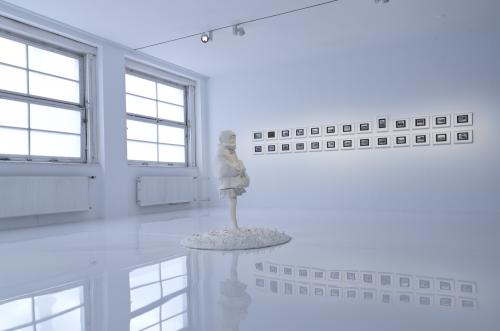
To fabricate her sculptures, Beliaeva connected with a workshop in Kyiv founded by ceramicists formerly at Kyiv Porcelain Factory, one of the larger factories. She digitally modeled the sculpture in Zbrush, broke them into six pieces each and 3D printed the molds, fired them, and assembled them using metal rods to support their structure. Jeff Koons has also worked with Soviet figurines. His inflatable ballerina that was last on view at Rockefeller Center in 2017 is a replica of the popular Soviet-era porcelain figurine by Oksana Zhnikrup. However, while Koons has tried to divorce the piece from its communist heritage, Beliaeva’s works play into them, highlighting their poetic and contradictory sensibilities.
Continuing to explore ceramic arts, Beliaeva was working on a new series centered on the high tiled ceramic stoves popularized in the 18th century that were installed in upper- and middle-class homes in major cities like Kyiv, Kharkiv, and Odesa when we spoke in February. Using Pinterest, she is collecting images of fireplaces and family and community portraits of people posing in front of various stoves in private homes, schools, and hospitals. Through this research the artist teased out her thesis, “the high-rise fireplace talks about the change of generations; how intimate space become public and private becomes common,” she said. City-planning was to be a key thematic: “It seems that the shape of these fireplaces foresaw the nature of the buildings of the next era,” Beliaeva commented. Indeed, their shape can be compared to the high-rise buildings that have come to replace historical buildings throughout Ukraine’s major cities. Speaking warmly about the project, Beliaeva hoped she would be able to recreate utilitarian versions using them to convey the human emotions behind processes of modernization.
The finished works are currently on view in her latest solo-show at OK Linz and have taken on a darker tone. Her process was influenced by the atrocities of war. Now, she sees in these objects a kind of memorial to a war that is being broadcast in real time throughout the media. Her works are a way for her to process the shock at what the world witnessed in the liberated town of Bucha in 2022. Based on her 3D prints, she worked with local fabricator Roland Hüttmayr to cast, fire, and assemble the pieces at Gmunden Ceramics. Her tiled stoves also tell of the existential suffering prevalent in Ukraine and of the security and energy crises that have made waves far beyond the country, cutting deep into our private sphere.
In addition to the sculptural works, Beliaeva’s photographs document the ruins of the typical apartment blocks where ordinary people live in Bucha, Irpin, and Borodianka. Scorch marks, bullet holes, and gaping wounds lay bare the structure of the burned-out houses. In the repeat pattern of a ceramic tile, these injuries are multiplied, forming the sooty black sculpture “Fragile City #2.” Tiled stoves stand for the cozy warmth of the home, and for Beliaeva they are furthermore prototypes of modernist architecture, early-twentieth-century utopias that were released in the uniform, omnipresent Soviet prefabricated buildings. The works contemplate the devastation and scars created by Russian attacks on Ukraine, both historical and contemporary.
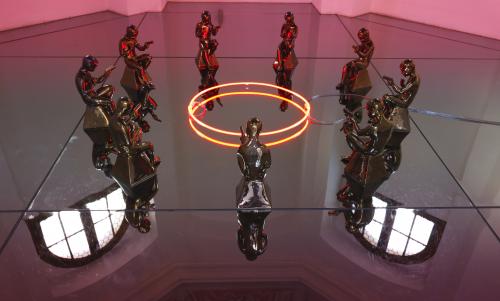
Hope in Motherhood, Sci-Fi, and Technology
During the Soviet-era the Ukrainian language along with many others were marginalized to make way for Russian that would help unify the USSR. Since the full-scale invasion, language has become a battleground with many Ukrainians choosing to speak only Ukrainian. Refusing to speak the [colonizer’s – ed.] language is a political act of resistance. Speaking to this topic, is “Veritas” a VR piece created with the British artist Isabel Bonafe. She explains that users can navigate a space scene littered with “cosmic trash,” asteroids floating and suspended in the sky that represent individual and collective memories. Nagging and ever-present. The work navigates both dystopia and utopia as the goal is to orient toward Venus, a planet similar to the Earth not yet destroyed by greenhouse gases. Speaking to Beliaeva I find that there is always a glimmer of hope and curiosity, the next step in this project, she explains, will be to create Venus.
Like “Veritas” which is entrenched within sci-fi rather than fantasy, “The Last Human Mother and Baby” made between 2015-2017 combines VR and digital prints. Taking place within a recreation of “The Hungry Lion Throws Itself on the Antelope” (1905) by the French naive painter Henri Rousseau, the series is centered around the scene of a mother holding her baby. Rousseau, a toll collector who never left France, invented jungle scenes from flora and fauna he saw at Paris’ botanical gardens, parks, and zoos. In France, there was a fascination for exotic scenes inspired by colonial expansion; Rousseau’s animal life amidst over-dimensioned foliage tells of these menaces. In Beliaeva’s print, it is not entirely clear whether or not the mother is protecting her infant, or ready to, as the lion aims to with the antelope in Rousseau's painting, devour him. Rousseau's primitive and instinctual expression drew her in. Many might feel close to the artists’ hormone-fueled feelings of new motherhood translated into this scene where the last woman is either a new beginning or, quite simply, the end.
Eyes lighting up Beliaeva tells me she has made a robot. It is a mechanism that allows a pen to travel across the page. Hooked up to a computer, the robot will draw for her when she does not feel like it. “We are moving closer to processes without people,” she says. Similarily to the Soviet Union’s glorification of the farmer, in her 2017 series “Working Class,” Beliaeva celebrates technology. The series consists of 3D printed sculptures of people in motion, working on computers and talking on cell phones. Although the characters are front and center, it is the technology–the 3D printer, laptop, and cell phone–that are the true focal points of this series that is shrouded in irony. In our post-internet society, it is the flow of information through these devices that shape our lives.
With great respect for both her subject matter and mediums, Beliaeva works with machines and human collaborators, learning to use both new and old technologies as she explores new futures that help her process the past, and an ever more challenging present.
In Closing
In February 2022, Beliaeva was also creating programming for SWAP, a project-space gallery in Kyiv that was going to show local and international artists. She hoped that SWAP would counter some of the favoritism that had shaped the local scene by introducing new artists. SWAP’s activities were for some time suspended as co-collaborators struggled to survive in war-torn Kyiv and elsewhere, but are active again.
”Of course, it’s a friendly call. Listen, if it wasn't friendly, you probably wouldn't have even got it,” U.S. President Muffley pleads over the phone with the President of the USSR Kissov in Stanley Kubrick’s cold-war satire “Dr. Strangelove.” Muffley is doing all he can to avoid nuclear warfare as he calls Kissov from the war room to alert him that American planes are on their way to drop hydrogen bombs on Soviet territory. "The Bomb Dimitri, The Hydrogen Bomb," he explains to the drunk Soviet leader suggesting that the USSR shot down the planes to deter the attack. Juggling a busy life as an artist, parent, and creative professional paired with the constant threat of war I understand why Beliaeva often returned to this twisted but comical scene.
__________________________________________
The project “Wanderings through Ukrainian Art” is a partnership collaboration between an online media Artslooker and an independent cultural organization BLOCKFREI Vienna. “Wanderings through Ukrainian Art” is supported by the House of Europe.
To read more articles about contemporary art please support Artslooker on Patreon
Share:
